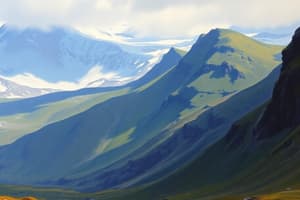Podcast
Questions and Answers
What primarily causes the formation of a U-shaped valley?
What primarily causes the formation of a U-shaped valley?
- Sediment deposition
- Wind erosion
- River erosion
- Glacial erosion (correct)
What is a characteristic shape of a corrie?
What is a characteristic shape of a corrie?
- Pyramidal with sharp peaks
- Amphitheater-shaped with steep sides (correct)
- Narrow and winding
- Flat and expansive
How is a pyramidal peak formed?
How is a pyramidal peak formed?
- By the converging of multiple V-shaped valleys
- From the collapse of a glacier
- By sediment deposition at higher elevations
- Through the erosion of multiple corries (correct)
Which feature is formed by tributary glaciers that erode less deeply?
Which feature is formed by tributary glaciers that erode less deeply?
What defines a V-shaped valley?
What defines a V-shaped valley?
What is the main material that composes a moraine?
What is the main material that composes a moraine?
What creates an arête?
What creates an arête?
Where do glaciers usually form?
Where do glaciers usually form?
A glacier moves through a pre-existing U-shaped valley.
A glacier moves through a pre-existing U-shaped valley.
A pyramidal peak is formed by the erosion of multiple arêtes around a central point.
A pyramidal peak is formed by the erosion of multiple arêtes around a central point.
V-shaped valleys are predominantly formed by glacial erosion.
V-shaped valleys are predominantly formed by glacial erosion.
Moraine consists of sorted glacial debris deposited by a glacier.
Moraine consists of sorted glacial debris deposited by a glacier.
Corrie is an amphitheater-shaped hollow formed by glacial erosion.
Corrie is an amphitheater-shaped hollow formed by glacial erosion.
An arête is formed between two smooth valleys.
An arête is formed between two smooth valleys.
A hanging valley is formed when tributary glaciers erode more deeply than the main glacier.
A hanging valley is formed when tributary glaciers erode more deeply than the main glacier.
Glaciers typically form in areas where summer melts exceed winter snowfall.
Glaciers typically form in areas where summer melts exceed winter snowfall.
Flashcards are hidden until you start studying
Study Notes
Glacier Overview
- A glacier is a large, slow-moving mass of ice formed from compacted snow layers.
- Movement results from the glacier's weight, occurring in regions with more snowfall in winter than summer melting.
U-Shaped Valley
- Created through glacial erosion in pre-existing V-shaped valleys.
- Characterized by a wide, deep cross-section with steep sides and a flat floor.
V-Shaped Valley
- Formed by river erosion in mountainous regions.
- Features steep sides and a narrow, winding valley floor.
Hanging Valley
- A smaller side valley that intersects with the main glacial valley at a higher elevation.
- Results when tributary glaciers erode less deeply than the main glacier, leaving tributary valleys elevated above the main valley.
Corrie (Cirque)
- An amphitheater-shaped hollow located at the glacier's head.
- Formed by glacial erosion combined with freeze-thaw weathering, resulting in snow accumulation and compression into ice that erodes the back wall and floor.
Pyramidal Peak
- A pointed mountain peak characterized by three or more sharp ridges known as arêtes radiating from it.
- Formed by the erosion of multiple corries surrounding a central point, sharpening the peak's structure.
Arête
- A sharp, narrow ridge that separates two corries or glacial valleys.
- Created by glaciers eroding the rock on both sides, leaving a distinct ridge.
Glacial Deposits
Moraine
- Composed of unsorted glacial debris, known as till, deposited by glaciers.
Glaciers Overview
- Large, slow-moving ice masses formed through compacted snow layers.
- Occur in regions with greater winter snow accumulation than summer melting.
U-Shaped Valley
- Created by glacial erosion in pre-existing V-shaped valleys.
- Features steep sides and a flat floor, resulting from the glacier's widening and deepening effect.
V-Shaped Valley
- Formed through river erosion, typical in mountainous terrains.
- Distinguished by steep sides and a narrow, winding floor.
Hanging Valley
- A smaller side valley that connects with the main glacial valley at a higher altitude.
- Results from tributary glaciers eroding less deeply than the main glacier, giving the appearance of being "hung."
Corrie (Cirque)
- An amphitheater-like hollow located at the glacier's head.
- Created by glacial erosion combined with freeze-thaw weathering, leading to snow accumulation and consequent erosion of the surrounding rock.
Pyramidal Peak
- A sharp, pointed mountain peak bordered by three or more arêtes.
- Formed from erosion by multiple corries surrounding a central peak, resulting in a distinct pyramidal shape.
Arête
- A narrow, sharp ridge created between two adjacent corries or glacial valleys.
- Formed by glacier erosion on either side, which carves out rock to create the ridge.
Glacial Deposits
- Composed of unsorted glacial debris known as till, deposited by glacier movement.
- Moraines are prominent features of glacial deposits, showcasing the accumulation of materials from glacial activity.
Studying That Suits You
Use AI to generate personalized quizzes and flashcards to suit your learning preferences.




